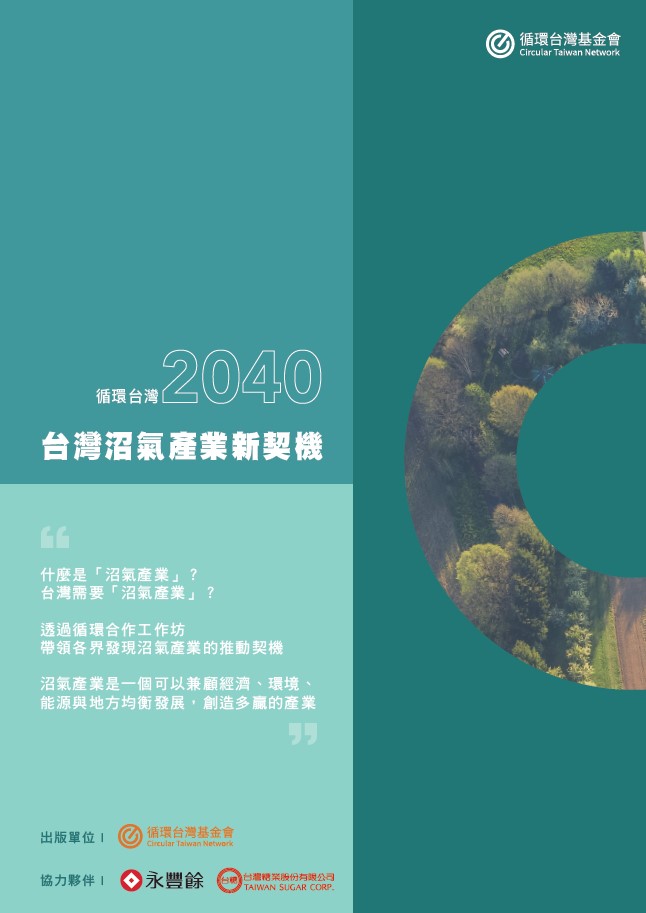Applying circular economy principles to sectors such as agriculture and food processing involves integrating upstream and downstream partners to optimize resource use and close the loop—this process is known as industrial circularity. As resources are circulated within such industrial systems, they often give rise to new and emerging industries—a phenomenon referred to as circular industrialization. Among these, biogas stands out as an industry with significant potential for circular industrialization.
Animal manure, food waste, and organic sludge—traditionally viewed as smelly, dirty, and problematic—have long been treated as nuisances to be avoided. However, within the framework of the circular economy, these waste streams are among Taiwan’s few domestically sourced and valuable resources. With proper planning and management, they can be repurposed to meet both energy and land use needs.
Agricultural by-products such as rice straw, rice husks, poultry and livestock manure, spent mushroom substrate, food processing sludge, and bagasse, as well as municipal organic waste like food scraps and sewage sludge, collectively amount to over 20 million metric tons per year. These are organic resources that do not rely on imports.
Applying one of the three key circular economy strategies—high-value circulation—organic resources should first be used for higher-value applications such as pharmaceuticals, specialty chemicals, food, feed, or bulk materials. When such uses are not feasible, collecting these resources and processing them via anaerobic digestion to produce biogas becomes a highly valuable alternative.
Through anaerobic digestion, organic resources are converted into biogas and digestate:
- Biogas can be used for electricity generation, heating, or further refined into renewable fuel.
- Digestate serves as a nutrient-rich fertilizer, supplying nitrogen, phosphorus, and potassium to the soil.

Incorporating circular economy thinking into agriculture and food processing industries involves integrating upstream and downstream players to maximize resource efficiency and achieve closed-loop systems—a process known as industrial circularity. Simultaneously, as these systems mature, they give rise to new industries, a process referred to as circular industrialization. Biogas is a leading candidate with high potential for such development.
According to our research and analysis, Taiwan generates over 20 million metric tons of organic resources each year. If we manage to recover just half, the economic, environmental, and social benefits could be significant:
- More Stable Renewable Power: Compared to solar and wind, which are weather-dependent, biogas provides a stable power source. Biogas power generation could produce over 1.6 billion kWh of electricity annually, enough to supply 450,000 households.
- Carbon Reduction: Biogas use could cut 1.1 million metric tons of CO₂e emissions—equivalent to the annual carbon sequestration of 2,800 Daan Forest Parks.
- Fertilizer Substitution: Biogas made from pig manure alone could yield digestate equivalent to 4 million bags of chemical fertilizer, representing 35% of Taiwan’s annual phosphorus fertilizer use, 20% potassium, and 15% nitrogen.
- Industrial Development and Job Creation: With the establishment of 150 centralized biogas facilities (each handling 200 tons/day), an estimated 4,500 direct and indirect jobs could be created.
Many countries have already recognized the potential of biogas and are rapidly scaling up related industries. For example, Germany has over 10,000 biogas power plants. In contrast, biogas facilities in Taiwan have traditionally been auxiliary systems in pig farms, primarily for wastewater treatment, without fully recognizing the industry’s energy and resource value.
If Taiwan rethinks its biogas strategy from the perspective of nationwide organic resource circulation, biogas could become a billion-dollar emerging industry with hundreds of full-scale plants. The value chain would include biogas power systems, feedstock collection and treatment, gas purification, and digestate utilization.
Due to its regional nature, the biogas industry can promote local industry development, investment, and employment. When paired with advanced ICT-based management systems, it can evolve into an efficient, hygienic, and visually integrated part of Taiwan’s clean energy future.
